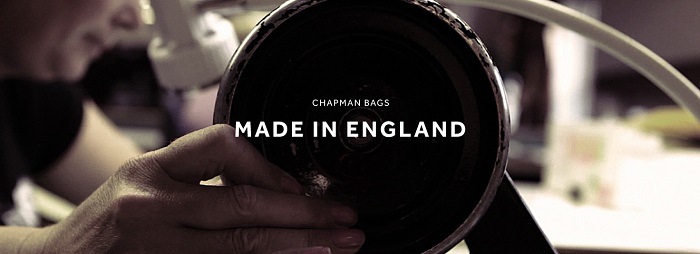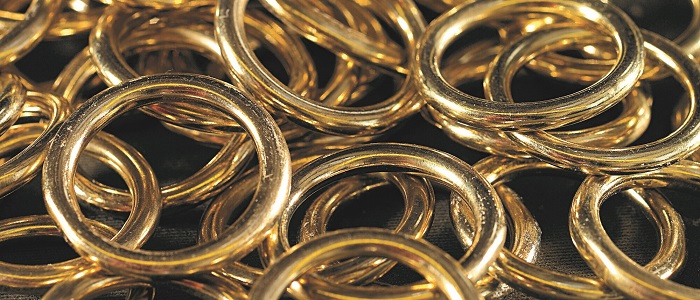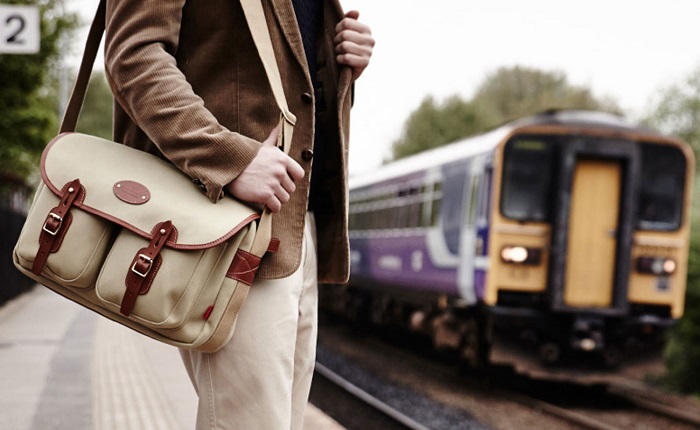 Guest columnist Daniel Chamier, founder of Chapman Bags, lays out eleven key points about the importance of knowing your bag and what it’s made of. Why eleven? One word: This is Spinal Tap The Movie.
Guest columnist Daniel Chamier, founder of Chapman Bags, lays out eleven key points about the importance of knowing your bag and what it’s made of. Why eleven? One word: This is Spinal Tap The Movie.
As OTC readers may know, Chapman is a manufacturer of authentically British made bags and luggage for men and women, all produced in its factory located in Carlisle, England. You can learn more about Chapman at www.chapmanbags.com and you can view a great brand video here.
NO BAG DOES IT ALL
No-one has yet designed a bag that does it all. You can, however, boil your collection down to around 3 styles, budget permitting and leaving aside performance equipment or functional stuff like rolling luggage.
The first is a handheld bag suitable for work, reasonably slim so you can travel without obstruction and suitable if necessary for wearing with a suit. In the old days this would have been a briefcase; nowadays the choice is much wider and many would include a tote in this category. The second is a piece of luggage suitable for carrying onto a plane or for a weekend away. While small pieces of rolling luggage are very popular, frankly they can look a bit naff trailing behind a bloke. Imagine turning up for a weekend somewhere and the first thing people notice is your plastic trolley: no. The third is more leisure orientated, likely to be carried on the shoulder or the back and could include a touring bag or a rucksack depending on your personal preference and habits.
DO YOU REALLY NEED ALL THOSE FEATURES?
If you are one of those people who need to have a different pocket for every item, you will probably need to go with a more contemporary bag made from synthetic materials. This is because only synthetic materials are light, strong and cheap enough to incorporate all those extra seams and pockets and additional material. Otherwise, my general view is that most bags only need a handful of essential features: first, an exterior pocket for keys and so forth; second, at least one internal divider or pocket to help with organisation; and finally in the case of luggage a lockable zip, the best being the kind with interlocking metal circles. What about my precious technology I hear you say? Well, although a lot of bags now make a big thing about padded technology compartments, the reality is that most people use protective sleeves and good quality bags should have inherent protection from the various layers of material in the bag; a padded pocket is more of a marketing ploy than a technical necessity.
YOU GENERALLY GET WHAT YOU PAY FOR
While labour rates vary enormously around the world, one thing which does not change much is the cost of high quality materials and fittings. The inevitable consequence of this is that if you buy a cheap bag, you will also be buying cheap materials and fittings. This is particularly relevant with bags, because once that zip or fastening has broken, your bag may be virtually useless. Beware especially cheap bags which look expensive. This can only be achieved by using second or third rate materials and the bag may well fail you quite quickly.
NO BAG WILL LAST FOREVER
Well that’s not strictly true, but it does depend how you use it. My general rule of thumb is that the life of a decent quality work bag can be measured as follows: Ly = 25/Dn where L equals the useful life of the bag in years and D equals the number of days a working week (defined as 5 days) it receives serious use. So if you use a good quality work bag hard every working day, it should last you around 5 years, or 10 years if only 2.5 days a week. Luggage can last a very long time indeed, a lifetime even, if used sparingly. You can help ensure your bags last longer by buying well and looking after them (see below!).
HOW TO CHECK IF LEATHER IS GOOD QUALITY
The most expensive bags are generally full leather, essentially because of the cost of the raw materials and, potentially, the amount of bench work involved in turning them into bags. So if you are paying top dollar for a leather bag, or just want to know how good the leather is on a cheaper bag, or whether it’s actually real leather at all, here are some tips. The first point to make is that there are lots of different types of leather, all used for different purposes: stiff bridle leather for equestrian work, soft chromed leather for car seats and fashion bags, vegetable tanned shoulders for straps and handles. Regardless of the type of leather, its quality will tend to be defined by the original skin and the length of time taken and process used to tan it. The cheapest leather is split leather (the split being the layer underneath the full grain once the skin has been split) where pigment is literally sprayed onto the leather. Split leather is used, for instance, on cheap leather satchels. High quality full grain leather starts at £5 a square foot and can easily run to £10 a square foot or more. Wastage (the leather rejected or unused from a skin) can easily be 25% or more; it’s impossible to make cheap bags from high quality leather.
If you are buying what you think is a leather bag and it’s relatively cheap compared to similar products, you should check whether it is actually made from real leather. Try googling the subject and you will find a wealth of advice on telling the difference between real and fake leather. I would not recommend the flame test (fake leather melts like plastic, real leather doesn’t!) but the tests I like are smell, feel and saliva. Fake leather doesn’t smell of leather. Real leather wrinkles and “gives” when you press it. Moisture is absorbed by real leather, not by fake leather. If your bag says “real leather”, seems surprisingly good value and the leather has a hard, wrinkly look to it, but it fails the smell, feel and saliva tests, that is because it’s actually split leather covered in a leather look plastic coating; for some reason brands can still get away with calling it leather! Look out also for vinyl substitution on binding, piping and fittings. Vinyl is not plastic, it’s a cellulosic material which is much cheaper than leather. You can generally tell vinyl fittings because they have a monotone appearance with little or no colour or grain variation. The absence of natural variation is usually a giveaway on man made materials, although not definitive, as real leather can be plated with artificial patterns (e.g. mock crock), in which case it should still pass the smell, feel and saliva tests.
Full grain leather can be tanned in different ways. Vegetable tanned leather has a natural looking appearance, with muted colours, will tend to mark and can fade in prolonged sunlight, but it ages with great character. Chromed leather can achieve much brighter colourways, will tend to age less visibly but marks may be more difficult to blend in. One way of testing the quality of leather is to find a piece you can bend and see what happens. If it starts to crack, best avoided. If it changes colour, this is not necessarily a sign of bad leather. For instance “pull up” leather visibly creases when bent but contains lots of fat and oil which then seep back into the grain, giving a rich and characterful look over time. If your bag has leather fittings (e.g. straps) check that these are robust, reasonably stiff and at least 2-3mm thick. Beware cheap leather fittings with interior fillers used to reduce cost; they may disintegrate. Avoid leather bags with poor quality edge paint on the side of straps, particularly the type of inflexible edge paint “filler” which cracks when bent. The edges of leather fittings on the finest quality bags will be sealed or turned to prevent the fibres of the leather fraying.
HOW TO CHECK IF CANVAS IS GOOD QUALITY
Originally canvas was a rough material woven from jute or hemp and often used for sail making. Modern canvas tends to be cotton. Its quality and fitness for purpose will depend on a number of factors including thickness, water proofing, lightfastness and abrasion resistance. My view is that Man Bags should be made from canvas of around 18oz weight or more, or they will tend to wear through relatively quickly. We do see quite a few thinner canvas bags these days with interliners to thicken the panels, but I don’t think this is great in a Man Bag and can be a sign of using cheap materials. The colours of all natural materials will tend to fade and wear over time. If this is a concern to you, then ask the manufacturers whether they test their materials for lightfastness and abrasion (dry and wet rub). Ideally canvas should be proofed (like waxed cotton) or laminated with a waterproof membrane to protect against rainfall. Canvas can also be coated with water repellent chemicals, which you can test quite easily with a drop of water rolling off the bag material rather than soaking in; OK maybe a bit tricky in a Bond Street store!
HARDWARE AND ZIPS
A bag’s functionality and longevity will also depend on the quality of the fastenings, closures and general hardware. Main zips should be made of metal (unless there is a specific reason for using a nylon zip such as on a gun cover) and run smoothly and securely. The best known manufacturers are YKK and RiRi, although the latter come at a substantial premium. Quality hardware is usually made from brass or brass coated with nickel, gold or copper plating. Steel hardware should be avoided as it will tend to rust. We also see a lot of specialist coatings now like “pewter”, “antique” and so forth. These may be fine but can disguise cheap alloy underneath; beware anything which feels unnaturally lightweight. Poor quality brass can often be identified by pitting on the surface of the metal.
CHECK A SHOULDER STRAP BOTH FOR MATERIAL AND FASTENINGS
Shoulder straps are vulnerable to two types of degradation. The first is damage to or degradation of the strap material. The second is failure of the strap fastenings (in the case of a detachable shoulder strap) or anchor points. There are many different types of shoulder strap material, including cotton or synthetic needle or shuttle loom webbing, safety belt type synthetics and full leather. The highest quality weave is shuttle loom, used for instance on parachute webbing. The lowest quality would be a loose needle loom webbing possibly with a filler inside. You may not be able to find out this kind of detail, so the rule of thumb is to make sure your strap has a nice thick webbing with a tight weave and a reasonable degree of stiffness. Safety belt webbing should be fairly indestructible but looks rather unattractive. The quality of full leather straps will depend on the leather itself (see above) and the fastenings. Make sure the latter are reasonably chunky and solid and the anchor points have lots of stitching. Remember also, rivets are less secure than stitches; in the wrong kind of material rivets are simply holes waiting to happen. Smaller anchor points on thinner material should ideally have reinforced back panels to avoid the material ripping.
CHECK THE WEAR POINTS
All bags have points which are subject to more stress than others. For instance, luggage will tend to stress around the base corners and the shoulder strap anchor points. Shoulder bags will tend to rub against the body in certain places and may also wear around the base corners when placed on the ground. Rucksack straps and back panels will be first in the firing line. Important fastenings like buckles, zips and straps will be potentially vulnerable on many bags. High quality bags will anticipate these issues by using expensive materials and fittings and by incorporating added protection like metal feet and leather panels and corners on potential wear points. A good tip is to stick to bags with simple fastenings and closures like buckles, straps and Sam Browne studs. Magnetic closures can work fine but are less secure and vulnerable to degradation, so best avoided on important Man Bag fastenings.
COLOURS DON’T LAST FOREVER
We all have our favourite colours but you need to remember that they will fade and wear in time, especially in natural materials like cotton canvas. Generally speaking dark colours fade more noticeably, especially Navy. Lighter colours like Khaki also fade but it’s less noticeable. Synthetic materials like nylon may retain their original colour for longer but they tend to wear less gracefully over time. Prolonged exposure to sunlight will wash out most colours quite quickly. In the desert, pretty much all colours end up looking the same after a while! This may sound alarming but when you think about it your work bag is unlikely to see that much direct sunlight even if you use it every day; unless of course you have a major walk or cycle to work, in which case you might want to get something a bit more prosaic for the journey and keep something nicer at work.
CARE, GUARANTEES AND REPAIRS
Never ever put your bag in a washing machine (yes, people do that). Don’t send it to be dry cleaned. Don’t leave it on a radiator when it’s got wet. Those are the three golden rules. Canvas or material bags should be cleaned with soapy water and left to dry naturally. Leather should be cleaned, perhaps with a lightly dampened cloth, left to dry naturally then rubbed with a leather cream or restorer. Although brass tarnishes naturally, hardware can be kept shiny with a metal cleaner. Some brands offer “lifetime” guarantees. This is more of a marketing ploy than anything else as the life of a bag will depend on how it’s used (see above). If you can, buy a bag from a brand who offer a repair and maintenance service.





Super article, and full of useful info… even stuff I was not aware of. I use the 5 senses test for leather (an extension of your smell, feel and saliva) – look, listen, touch, smell, taste (yup even taste!)
And don’t forget to consider the lining on a bag. Some leather bags are unlined, whilst others make a point of using canvas, silk or even suede.
Great article. Especially the tips about the leather quality. I’m planning to buy a leather bag and will definitely follow your advise. Maybe not taste it. Could raise some heads in the shop when you start eating their bags 🙂